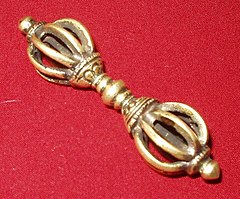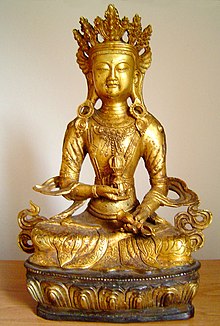Vajra

Vajra (Devanagari: वज्र) is a Sanskrit word meaning both thunderbolt and diamond and is the most important of all Buddhist symbols. It is a short metal weapon that has the nature of a diamond (it can cut any substance but not be cut itself) and the nature of the thunderbolt (irresistible force). The vajra has come to represent firmness of spirit and sprirtual power. This is ritual tool or spiritual implement which is symbolically used by Buddhism, Jainism and Hinduism. In Jainism , it is the symbol or mark for one of the Thirthankars namely Dharmanatha.
The equivalent word in Tibetan is dorje (Wylie: rdo-rje; ZYPY: dojê), which is also a common male name in Tibet and Bhutan. Dorje can also refer to a small sceptre held in the right hand by Tibetan lamas during religious ceremonies.
Hinduism

In Hindu mythology, Vajra is the weapon of Indra, the Vedic god of rain and king of Devas. It is a powerful weapon having the combined features of sword, mace, and spear.
Tantric Buddhism
In Tantric Buddhism the vajra represents the male sexual organ, cosmic force, and compassion. The bell symbolizes the female sexual organ, the female cosmic force principle, and the virtue of wisdom. Some deities are shown holding each part of the vajra in separate hands, this symbolizes the union of the forces of compassion and wisdom.
Vajra and Vajrayana
The vajra destroys all kinds of ignorance, and itself is indestructible. In tantric rituals the Vajra symbolizes the male principle which represents method in the right hand and the Bell symbolizes the female principle, which is held in the left. Their interaction leads to enlightenment. Also the Dorje or Vajra represents the "Upaya" or method Tibetans name Vajra as "Dorje". When made to be worn as a pendant, it reminds the wearer, and the viewer, of the supreme indestructibility of knowledge.
In Buddhism the vajra is the symbol of Vajrayana, one of the three major branches of Buddhism. Vajrayana is translated as "Thunderbolt Way" or "Diamond Way" and can imply the thunderbolt experience of Buddhist enlightenment or bodhi and also implies indestructibility, just as diamonds are harder than other gemstones.

In the tantric traditions of both Buddhism and Hinduism, the vajra is a symbol for the nature of reality, or sunyata, indicating endless creativity, potency, and skillful activity. The term is employed extensively in tantric literature: the term for the spiritual teacher is the vajracarya; instead of bodhisattva, we have vajrasattva, and so on. The practice of prefixing terms, names, places, and so on by vajra represents the conscious attempt to recognize the transcendental aspect of all phenomena; it became part of the process of "sacramentalizing" the activities of the spiritual practitioner and encouraged him to engage all his psychophysical energies in the spiritual life.
An instrument symbolizing vajra is also extensively used in the rituals of the tantra. It consists of a spherical central section, with two symmetrical sets of five prongs, which arc out from lotus blooms on either side of the sphere and come to a point at two points equidistant from the centre, thus giving it the appearance of a "diamond sceptre", which is how the term is sometimes translated.
Various figures in Tantric iconography are represented holding or wielding the vajra. Three of the most famous of these are Vajrasattva, Vajrapani, and Padmasambhava. Vajrasattva (lit. vajra-being) holds the vajra, in his right hand, to his heart. The figure of the Wrathful Vajrapani (lit. vajra in the hand) brandishes the vajra, in his right hand, above his head. Padmasambhava holds the vajra above his right knee in his right hand.
Symbolism
The vajra is made up of several parts:
In the center is a sphere which represents Sunyata, the primordial nature of the universe, the underlying unity of all things.
Emerging from the sphere are two eight petalled lotus flowers. One represents the phenomenal world (or in Buddhist terms Samsara), the other represents the noumenal world (or Nirvana). This is one of the fundamental dichotomies which are perceived by the unenlightened.
Arranged equally around the mouth of the lotus are two, four, or eight mythical creatures which are called makaras. These are mythological half-fish, half-crocodile creatures made up of two or more animals, often representing the union of opposites, (or a harmonisation of qualities that transcend our usual experience).
From the mouths of the makaras come tongues which come together in a point.
The five pronged vajra (with four makaras, plus a central prong) is the most commonly seen vajra. There is an elaborate system of correspondences between the five elements of the noumenal side of the vajra, and the phenomenal side. One important correspondence is between the five "poisons" with the five wisdoms. The five poisons are the mental states that obscure the original purity of a being's mind, while the five wisdoms are the five most important aspects of the enlightened mind. Each of the five wisdoms is also associated with a Buddha figure. (see also Five Wisdom Buddhas)
The following are the five poisons and the analogous five wisdoms with their associated Buddha figures:[citation needed]
| Poison | Wisdom | Buddha |
|---|---|---|
| desire | wisdom of individuality | Amitabha |
| anger, hatred | mirror-like wisdom | Akshobhya |
| delusion | reality wisdom | Vairocana |
| greed, pride | wisdom of equanimity | Ratnasambhava |
| envy | all-accomplishing wisdom | Amoghasiddhi |
The wisdom of individuality is also known as Discriminating Wisdom.
See also
References
- Dallapiccola, Anna L. Dictionary of Hindu Lore and Legend. ISBN 0-500-51088-1
- Vessantara. Meeting The Buddhas. Windhorse Publications, 2003.
- Vessantara. Vajra and Bell. Windhorse Publications, 2001.
- McArthur, Meher. Reading Buddhist Art: An Illustrated Guide to Buddhist Signs And Symbols. Thames & Hudson Ltd, 2002.

